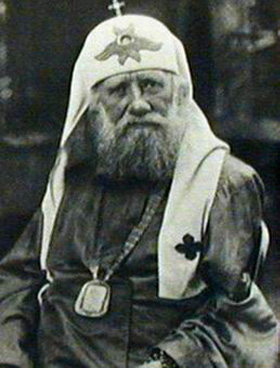
Patriarch Tikhon''''s Catacomb Church. History of the Russian True Orthodox Church
Patriarch Tikhon's Catacomb Church
History of the Russian True Orthodox Church
The Russian True Orthodox Church (RTOC), also known as the Catacomb Church - a canonical rightful successor to the Tikhonite Local All-Russian Church, was fully organized in the late twenties and early thirties of the twentieth century because most of the episcopate and clergy refused to collaborate with the ungodly theomachistic communist regime. At the same time, the "Renovationist Church" also known as the "Living Church" was formed. The Orthodox Russian people refused to attend these churches and their authority in Russia eventually vanished. Then, in 1943 under Stalin's order, "The Moscow Patriarchate" was organized and became the official "Soviet" or "Red Church", headed by Metropolitan Sergius Stragorodsky. Along side of her, the RTOC continued to secretly exist. The RTOC, severely repressed and persecuted, and compelled to an "illegal way of servitude", went underground and became known as the "Catacomb Church".
This branch, once part of the Local Russian Church is also called "Tikhonovskaya" after Saint Patriarch Tikhon (Bellavin, +1925) whose will and legacy all these years has been sacredly observed by the faithful of the catacomb RTOC in the homeland.
The canonical foundation of the RTOC is based on the prophetic decree of the last lawfully elected (by the All-Russian Local Council expressing the full will of the Russian Church) head of the Russian Church Saint Patriarch Tikhon , well known as Decree #362 dated November 20, 1920.
St. Patriarch Tikhon summoned all his strength to save the Holy Russian Church, while it received some of the most cruel and severe blows from the communists. Prophetically, he foresaw two forms of church governance. One was expressed in the Patriarch's Will dated January, 7, 1925, which was promulgated immediately after the mysterious death of the Most Holy. He fully understood that the goal of the theomachists was to annihilate the True Church of Christ and to not allow a local council to gather for the election of a new lawful Patriarch, thus depriving the church of canonical leadership. Therefore, St. Patriarch Tikhon, according to the decision of the local council of 1917-1918, appointed substitutes for the Locum Tenens to the Patrirachal Throne: Metropolitan Cyril (Smirnov) of Kazansk (in retrospect one of the founding fathers of the Catacomb Church), Metropolitan Agafangel (Preobrozhenskiy) of Yaroslavsk, and Metropolitan Peter (Polanskiy) of Krutitsk. The Will, specifically stipulated that, if Metropolitan Cyril, due to unmitigating circumstances was unable to become the rightful substitute of the Locum Tenens to the Patriarchal Throne, then Metropolitan Agafangel was to replace him. If this could not be accomplished by either Metropolitan Cyril or Metropolitan Agafagel, then the rights were transfered to Metropolitan Peter. As is known, Metropolitan Cyril and Metropolitan Agafangel were arrested by the communists. In accordance with the Will of St. Patriarch Tikhon, his Holiness Peter would come to bear the heavy cross of leadership. Himself under persecution, having a premonition of his impending arrest, Metropolitan Peter also appointed temporary substitutes of the Locum Tenens to the Patriarchal Throne. Among them, the founding father of the Catacomb Church, The New Martyr of Russia, St. Metropolitan Joseph (Petrovich, +1937) of St. Petersburg.
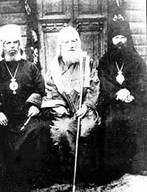
The primary reason for establishing the Substitute Locum Tenens was to call together at first opportunity the election of a new canonical Patriarch and restore legitimate authority in the Russian Orthodox Church. Such a secret council was held in 1926 by petition of all the Orthodox Bishops. As a result, more than 70 Bishops of the Russian Church voted to elect as the new Patriarch, St. Metropolitan Cyril (Smirnov, +1937) of Kazansk. Because of the counteractions of the communist authorities, the resolutions of this Council were never realized. Instead, Metropolitan Sergius Stragorodsky, with the help of the GPU (Secret Police), usurped church authority and with the Renovationists, caused a terrible split in the church. The majority of the council participants were arrested and finished their lives in prison camps.
Anticipating a similar turn of events, Saint Patriarch Tikhon prophetically forethought another form of church governance for the Russian Church in case the actions of the lawful Highest Church Authorities were terminated. This form of church governance is stipulated by St. Patriarch Tikhon's Decree #362 November 20, 1920, on whose principals the Catacomb True Orthodox Church was founded in the homeland, and in exile, the Russian Orthodox Church Abroad. The main point of St Patriarch Tikhon's prophetic Decree all comes down to; If the Higher Church Administration itself, headed by His Holiness the Patriarchate, for any reason whatsoever ceases its activity, the diocesan bishop immediately enters into relations with the bishops of neighboring dioceses for the purpose of organizing a higher instance of ecclesiastical authority for several dioceses in similar conditions (in the form of a temporary Higher Church government or a Metropolitan district, or anything else). In the case of the impossibility of establishing relations with bishops of neighboring dioceses, and until the organization of a higher instance of ecclesiastical authority, the diocesan bishop takes upon himself all the fullness of authority granted him by the cannons of the Church. And, in the case of the extreme disorganization of ecclesiastical life, when certain persons and parishes cease to recognize the authority of the diocesan bishop, the latter, as stated in the Decree, does not relinquish his Episcopal powers, but forms deaneries and a diocese; he permits where necessary, that the divine services be celebrated even in private homes and other places suited therefore, and severs ecclesiastical communion with the disobedient.
During St. Patriarch Tikhon's lifetime, this form of church government had already taken root and after the Patriarch's arrest, his replacement, Metropolitan Agafangel in his message of June 28, 1922, ordered all bishops to transition to Decree #362.

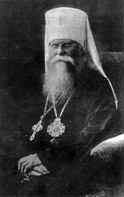
Founding Fathers of the Catacomb Russian True Orthodox Church -
The Holy New Martyrs of Russia, Metroplotan Cyril (Smirnov, +1937)
of Kazansk (left) and St. Joseph (Petrovich, +1937) of St. Petersburg
Life itself, confirmed the prophetical wisdom of this Decree. After the arrest of Metropolitan Peter, the Substitute to the Locum Tenens to the Patriarchial Throne, Metropolitan Sergius Stragorodsky, illegally, with the aid of the GPU, aligned himself with the Renovationists and the Highest Church Authority and betrayed the Church of Christ, to the communists. Consequently, he was rejected by the majority of orthodox pastors and believers, including the two specified in St.Patriarch Tikhon's Will: Metropolitans Cyril of Kazansk and Agafangel of Yaroslavsk, together with the incarcerated Metropolitan Peter, of Krutitsk and his appointed deputy, Metropolitan Joseph of Petrograd. In essence, the episcopate of the Russian Church canonically remained with St. Patriarch Tikhon's Decree #362 and did not enter into dialogue with the illegal Renovationist Church. Thus, going into the catacombs, "The Russian True Orthodox Church" began its survival in the homeland. Analogously, acting upon the same principles of the Decree #362, the Russian Orthodox Bishops in Exile, organized "The Highest Church Authority of the Russian Orthodox Church Abroad" and in doing so, began their independent existence as the Russian Church Abroad.
To this day the "Tikhonovskaya"--Russian True Orthodox Church has survived, having been subjected to reprisals and persecutions, prisons and executions, conspiracies. However, in the underground it remained attentive to the spirit of true belief, through piety and in suffering, all in a spirit of internal church peace and freedom. Principally, the RTOC does not participate in any political movements and ideologies, keeping to the traditions of the Catacomb Church. The governing principles by which the RTOC is guided are as follows: to safeguard the purity of the True Russian Orthodox Faith and the preservation of an internal church freedom, free from destructive influences and elements of the world. The governing body of the church is the Synod of Bishops of the Russian True Orthodox Church.
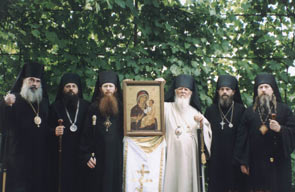
Member Bishops of the Synod of the Russian True Orthodox Church
The founding of the Synod of the Russian True Orthodox Church was formed with the blessing of the lawful First Hierarch of the Russian Orthodox Church Abroad, Metropolitan Vitaly by an order dated March 11, 2002.
The Synod of RTOC continues to be guided by the principles of St. Patriarch Tikhon's Decree #362 from 1920, "Regarding diocesan self-rule".
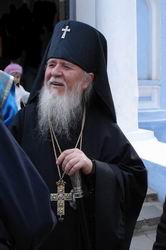
Archbishop Lazar (Jurbenko, 1931-2005)
Schema-Monk Archbishop Lazar (Jurbenko) of Odessa and Tambov, Chairman of the Synod of Bishops until 2005, was the oldest hierarch in the Russian True Orthodox Church. A long-term prisoner of Stalin's concentration camps for his association with the RTOC, was secretly tonsured Bishop for the Catacomb Church in 1982, with the assistance of the Russian Orthodox Church Abroad.
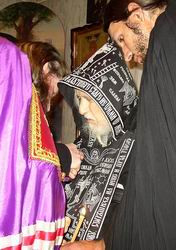
On June 30, 2005, during the fast of the Holy Apostles Peter and Paul, Schema-Monk Archbishop Lazar (Jurbenko), peacefully reposed in the Lord. On July 7, 2005, elections for a new Head of the Russian True Orthodox Church took place. By secret ballot, the majority of votes elected the Right Reverend Bishop of Omsk and Siberia, Tikhon (Pasechnik). The following day in the Cathedral of St. John of Krondstad, in Odessa, during Divine Liturgy, the Right Reverend Bishop Tikhon was elevated to the order of Archbishop. Elected as Vice-Chairman by the Synod of Bishops was the Right Reverend Archbishop Venjamin (Rusalenko), of the Black Sea and Kuban Diocese. Elected as Secretary of the Synod of Bishops was the Right Reverend Bishop Dionisy (Alferov), of the Novgorod and Tver Diocese.
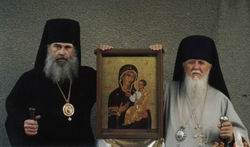
Archbishop Lazar and Bishop Tikhon with the Wonder-Working Iveron
Icon of the "Holy Virgin Mary, Mother of God--Sweet Smelling".
The Russian True Orthodox Church consist of six dioceses: Omsko-Sibirskaja, Odessa-Kharkovskaja, Black Sea-Kubanskaja, Chernigovsko-Gomelskaja, Novgorodsko-Tverskaja, Vernensko- Semirechenskaja (Kazakhstan). Located in the Odessa Diocese is the Pastoral Educational Center named after St. John of Krondstad.
The name "Russian True Orthodox Church" historically belongs to the Catacomb Church. Since 1982 until 2005, the RTOC was spiritually headed by Bishop Lazar and continues to grow spiritually under the leadership of Archbishop Tikhon, of Omsk and Siberia.
Having been witness to the path ROCOR embarked upon, specifically seeking unity with the Moscow Patriarchate, an organization who is a member of the WCC and unrepentant of its Sergianist past, we requested to be accepted under the omophorion of the Russian True Orthodox Church. On December 29, 2005, we were granted acceptance by the Synod of Bishops of the Russian True Orthodox Church and placed under the direct auspices of His Eminence Archbishop Tikhon, of Omsk and Siberia.
-------------------------------------------------------------
Residence of the First Hierarch of The Synod
of the True Orthodox Church
Archbishop of Omsk and Siberia Tikhon:

Cathedral Temple of Holy Tsar Martyrs
644047, Russia, Оmsk-47, 3rd Remeslennaya Str., 34
Tel.: 8-10-7-3812-24-34-82
E-mail of the Chancellery of the Archbishop’s Synod of RTOC: sinod_ipc@catacomb.org.ua
_________________________________________
http://catacomb.org.ua/modules.php?name=Pages&go=page&pid=1098
2. Address-Appeal to the Clergy and Faithful Sons and Daughters of the Russian Orthodox Church Abroad from the First Hierarch of the Synod of the True Orthodox Church Archbishop Tikhon
Обращение - Призыв Председателя Архиерейского Синода Русской Истинно-Православной Церкви Архиепископа Тихона к духовенству и верным чадам Русской Зарубежной Церкви (на английском и русском языках)
http://catacomb.org.ua/modules.php?name=Pages&go=page&pid=902
